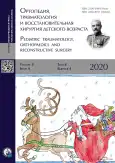Ретрокливальная гематома. Обзор литературы и описание двух клинических случаев
- Авторы: Ходоровская А.М.1,2, Кондрашев И.А.1, Мандал В.1, Ляпин А.П.1
-
Учреждения:
- Санкт-Петербургское государственное бюджетное учреждение здравоохранения «Детская городская клиническая больница № 5 им. Н.Ф. Филатова»
- Федеральное государственное бюджетное учреждение «Национальный медицинский исследовательский центр детской травматологии и ортопедии имени Г.И. Турнера» Министерства здравоохранения Российской Федерации
- Выпуск: Том 8, № 4 (2020)
- Страницы: 467-472
- Раздел: Клинические случаи
- URL: https://journal-vniispk.ru/turner/article/view/33920
- DOI: https://doi.org/10.17816/PTORS33920
- ID: 33920
Цитировать
Аннотация
Обоснование. Ретрокливальная гематома относительно редкая травматическая патология, частота встречаемости которой составляет 0,01–0,6 % всех случаев черепно-мозговой травмы. Ретрокливальные гематомы являются редкой травматической патологией задней черепной ямки, характерной преимущественно для детей. В литературе описаны клинические случаи в основном эпидуральных ретрокливальных гематом.
Клинические наблюдения. Представлены два клинических наблюдения ретрокливальной эпидуральной гематомы и ретрокливальной субдуральной гематомы у детей. Данные травматические повреждения возникли вследствие высокоэнергетической травмы (дорожно-транспортного происшествия).
Обсуждение. Приведен обзор литературы и обсуждены топографо-анатомические и нейровизуализационные особенности ретрокливальной области, обусловленные наличием различных компартментов и, соответственно, различных видов повреждения ретрокливальной области.
Заключение. С учетом неспецифичности клинической картины, а также особых топографических взаимоотношений анатомических структур ретрокливальной области достоверным методом диагностики данной патологии является нейровизуализация, которая позволяет уточнить характер повреждения и определить тактику лечения.
Полный текст
Открыть статью на сайте журналаОб авторах
Алина Михайловна Ходоровская
Санкт-Петербургское государственное бюджетное учреждение здравоохранения «Детская городская клиническая больница № 5 им. Н.Ф. Филатова»; Федеральное государственное бюджетное учреждение «Национальный медицинский исследовательский центр детской травматологии и ортопедии имени Г.И. Турнера» Министерства здравоохранения Российской Федерации
Автор, ответственный за переписку.
Email: alinamyh@gmail.com
ORCID iD: 0000-0002-2772-6747
SPIN-код: 3348-8038
врач-нейрохирург амбулаторно-консультативного отделения; научный сотрудник лаборатории физиологических и биомеханических исследований
Россия, Санкт-ПетербургИгорь Анатольевич Кондрашев
Санкт-Петербургское государственное бюджетное учреждение здравоохранения «Детская городская клиническая больница № 5 им. Н.Ф. Филатова»
Email: kigan777@gmail.com
ORCID iD: 0000-0002-3086-4358
канд. мед. наук, заслуженный врач РФ, заведующий отделением лучевой диагностики
Россия, Санкт-ПетербургВайшали Мандал
Санкт-Петербургское государственное бюджетное учреждение здравоохранения «Детская городская клиническая больница № 5 им. Н.Ф. Филатова»
Email: bitctmri2001@mail.ru
ORCID iD: 0000-0002-9211-1378
канд. мед. наук, врач-рентгенолог отделения лучевой диагностики
Россия, Санкт-ПетербургАндрей Петрович Ляпин
Санкт-Петербургское государственное бюджетное учреждение здравоохранения «Детская городская клиническая больница № 5 им. Н.Ф. Филатова»
Email: aplapin@mail.ru
заведующий отделением нейрохирургии
Россия, Санкт-ПетербургСписок литературы
- Крылов В.В., Талыпов А.Э., Ткачев В.В. Повреждения задней черепной ямки. – М.: Медицина, 2005. [Krylov VV, Talypov AE, Tkachev VV. Povrezhdeniya zadney cherepnoy yamki. Moscow: Meditsina; 2005. (In Russ.)]
- Casey D, Chaudhary BR, Leach PA, et al. Traumatic clival subdural hematoma in an adult. J Neurosurg. 2009;110(6):1238-1241. https://doi.org/10.3171/ 2008.9.JNS17651.
- Ahn ES, Smith ER. Acute clival and spinal subdural hematoma with spontaneous resolution: Clinical and radiographic correlation in support of a proposed pathophysiological mechanism. Case report. J Neurosurg. 2005;103(2 Suppl):175-179. https://doi.org/10.3171/ped.2005.103.2.0175.
- Anik I, Ceylan S, Koc K, et al. Microsurgical and endoscopic anatomy of Liliequist’s membrane and the prepontine membranes: Cadaveric study and clinical implications. Acta Neurochir (Wien). 2011;153(8):1701-1711. https://doi.org/10.1007/s00701-011-0978-5.
- Coleman CC, Thompson JL. Extradural hemorrhage in the posterior fossa. Surgery. 1941;10(6):985-990. https://doi.org/10.5555/uri:pii:S003960604190243X.
- Agrawal D, Cochrane DD. Traumatic retroclival epidural hematoma — a pediatric entity? Childs Nerv Syst. 2006;22(7):670-673. https://doi.org/10.1007/s00381-006-0059-x.
- Haines DE, Harkey HL, al-Mefty O. The “subdural” space: A new look at an outdated concept. Neurosurgery. 1993;32(1):111-120. https://doi.org/10.1227/00006123-199301000-00017.
- Guillaume D, Menezes AH. Retroclival hematoma in the pediatric population. Report of two cases and review of the literature. J Neurosurg. 2006;105(4 Suppl):321-325. https://doi.org/10.3171/ped.2006.105.4.321.
- Paterakis KN, Karantanas AH, Hadjigeorgiou GM, et al. Retroclival epidural hematoma secondary to a longitudinal clivus fracture. Clin Neurol Neurosurg. 2005;108(1): 67-72. https://doi.org/10.1016/j.clineuro.2004.11.010.
- Kurosu A, Amano K, Kubo O, et al. Clivus epidural hematoma. Case report. J Neurosurg. 1990;72(4):660-662. https://doi.org/10.3171/jns.1990.72.4.0660.
- Samanci Y, Baskurt I, Celik SE. Traumatic retroclival epidural hematoma. Pediatr Emerg Care. 2019;35(10):e184-e187. https://doi.org/10.1097/PEC.0000000000001756.
- Koshy J, Scheurkogel MM, Clough L, et al. Neuroimaging findings of retroclival hemorrhage in children: A diagnostic conundrum. Childs Nerv Syst. 2014;30(5):835-839. https://doi.org/10.1007/s00381-014-2369-8.
- Silvera VM, Danehy AR, Newton AW, et al. Retroclival collections associated with abusive head trauma in children. Pediatr Radiol. 2014;44 Suppl 4:S621-631. https://doi.org/10.1007/s00247-014-3170-2.
- Ratilal B, Castanho P, Vara Luiz C, Antunes JO. Traumatic clivus epidural hematoma: Case report and review of the literature. Surg Neurol. 2006;66(2):200-202. https://doi.org/10.1016/j.surneu.2005.11.030.
- Yama N, Kano H, Nara S, et al. The value of multidetector row computed tomography in the diagnosis of traumatic clivus epidural hematoma in children: A three-year experience. J Trauma. 2007;62(4):898-901. https://doi.org/10.1097/01.ta.0000221058.72995.c9.
- Kwon TH, Joy H, Park YK, Chung HS. Traumatic retroclival epidural hematoma in a child: Case report. Neurol Med Chir (Tokyo). 2008;48(8):347-350. https://doi.org/10.2176/nmc.48.347.
- Nguyen HS, Shabani S, Lew S. Isolated traumatic retroclival hematoma: Case report and review of literature. Childs Nerv Syst. 2016;32(9):1749-1755. https://doi.org/10.1007/s00381-016-3098-y.
- Tubbs RS, Griessenauer CJ, Hankinson T, et al. Retroclival epidural hematomas: A clinical series. Neurosurgery. 2010;67(2):404-406. https://doi.org/10.1227/01.NEU.0000372085.70895.E7.
- Meoded A, Singhi S, Poretti A, et al. Tectorial membrane injury: Frequently overlooked in pediatric traumatic head injury. AJNR Am J Neuroradiol. 2011;32(10):1806-1811. https://doi.org/10.3174/ajnr.A2606.
- Papadopoulos SM, Dickman CA, Sonntag VK, et al. Traumatic atlantooccipital dislocation with survival. Neurosurgery. 1991;28(4):574-579. https://doi.org/10.1097/00006123-199104000-00015.
- Marks SM, Paramaraswaren RN, Johnston RA. Transoral evacuation of a clivus extradural haematoma with good recovery: A case report. Br J Neurosurg. 1997;11(3):245-247. https://doi.org/10.1080/02688699746339.
- Yang BP. Traumatic retroclival epidural hematoma in a child. Pediatr Neurosurg. 2003;39(6):339-340. https://doi.org/10.1159/000075264.
- Desimpel J, Parizel PM, Dekeyzer S. Posttraumatic retroclival hematoma: A case report. Acta Neurol Belg. 2020;120(1):177-178. https://doi.org/10.1007/s13760-019-01117-3.
- Zabalo G, Ortega R, Diaz J, et al. Retroclival epidural haematoma: A diagnosis to suspect. Report of three cases and review of the literature. Acta Neurochir (Wien). 2017;159(8):1571-1576. https://doi.org/10.1007/s00701-017-3214-0.
Дополнительные файлы













